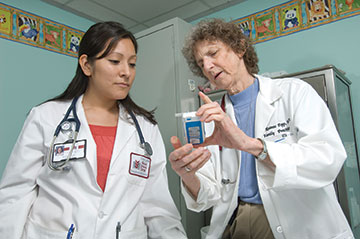Your statewide preceptorship program needs you
Your statewide preceptorship program needs you
By Rachel Dorn
Coordinator, Texas Statewide Family Medicine Preceptorship Program
Since 1985, the Texas Statewide Family Medicine Preceptorship Program has been matching pre-clinical medical students with family physicians throughout the state of Texas. The summer pre-clinical program provides an opportunity for students who have completed their first year of medical school to work in the office of an established family physician in order to gain real, hands-on, clinical experience early in their medical school career. Through this summer program, over 4,000 pre-clinical students from every medical school in Texas have been exposed to the difficulties and rewards of maintaining a family medicine practice, and the relationships between family physicians and other health care providers and the community.
Many students cite their participation in the TSFMPP as a pivotal experience in their medical school career. The continued success of the program and the increase in students ultimately choosing family medicine as a career attests to the effectiveness of the preceptorship program. In recent years, however, the growing needs of medical schools and the increasing load of students and residents at all levels of education have resulted in a higher demand for community-based family physician educators. Many of the TSFMPP’s current preceptors also devote their time to residents and clinical students. Additionally, the transition of medical practices to electronic records and increased pressures of managed care have served as added challenges and demands on the voluntary teaching time of family medicine preceptors.

Houston preceptor Rosanne Popp, M.D., right, teaches Texas A&M Temple medical student Eva Chavez, left.
Despite these challenges, there is an ongoing need for all medical schools to recognize that more emphasis should be placed on promoting family medicine preceptorship experiences, particularly in rural and underserved areas. TSFMPP takes on an even greater significance in medical schools that require little exposure to family medicine, and in which rural and underserved training opportunities are even more limited. According to a 2004 study published in Academic Medicine, the proportion of students choosing family medicine residencies among TSFMPP participants was significantly higher than among nonparticipants. In order to help meet the workforce needs in Texas, it is now more important than ever for family physicians to nurture and protect the special tradition of experienced physicians teaching future physicians and sharing the unique qualities and values that define the profession.
Though the benefits to student participants are obvious, many current preceptors have also cited their involvement as abundantly rewarding. TSFMPP preceptors are devoted mentors and teachers who are committed to ensuring the growth and success of future physicians, and many preceptors forge ongoing relationships with their students, following their development and providing support and guidance throughout the students’ transition into a career as a family physician. Pre-clinical preceptors from nearly every corner of Texas volunteer between two weeks to four months of their summer to teach and host students in their offices and clinics. Additionally, many preceptors provide lodging for students to help defray the costs of relocating to a rural site for the duration of the preceptorship.
Although preceptors serve voluntarily and are unpaid, the Texas Higher Education Coordinating Board provides funds to support a central preceptorship office and offer stipends to participating students. Student stipends range from $375 to $1000, depending on the length of the preceptorship and whether or not the student is participating in a rural or underserved area. During the preceptorship, pre-clinical students have the opportunity to enhance their classroom instruction through hands-on learning, including history-taking, physical examination, early diagnosis, and treatment plan formulations. Students also gain insight into the lifestyle of a family physician and learn more about what goes into running a practice.
Similar preceptorship programs provide pre-clinical experiences for students interested in general internal medicine and pediatrics; however, the family medicine program has the largest membership of participating preceptors from across the state. Despite TSFMPP’s broad pool of preceptors, student applicants are often unable to be placed because of the lack of available physicians. Throughout the last few years the number of participating preceptors accepting pre-clinical students has consistently declined from 125 in 2006 to now approximately 100. Participating preceptors in rural communities are currently limited to just 22 locations. With more than 170 student applicants in 2009, TSFMPP is in dire need of more pre-clinical summer preceptors.
To support the family medicine preceptors and enable each physician to feel well-prepared to teach medical students, the preceptorship program works in collaboration with the Faculty Development Center in Waco to provide training workshops and clinical teaching resources for interested preceptors. Additionally, every preceptor receives outlined learning objectives for students, as well as an evaluation form which provides a way for both preceptors and students to give constructive feedback on the program and their experiences. TSFMPP preceptors are also eligible to submit teaching hours towards CME credit as recognized by AAFP.
Some recent initiatives of the preceptorship program include providing more training materials, resources, and pertinent forms on the program website in order to be easily accessible to preceptors. The program website currently allows student applicants to browse preceptor profiles to learn more about individual practice locations and make requests for specific physicians and clinics. The website will also feature a photo gallery, recent news articles, and links to the program’s Facebook page and LinkedIn group. Interested physicians are encouraged to visit the website to learn more about program eligibility and register as a preceptor. Students will apply for the summer 2011 program beginning in January 2011.
For program inquiries or questions on how to become a preceptor, contact Rachel Dorn at rachel.a.dorn@uth.tmc.edu or (713) 500-7615 or visit the preceptorship online at www2.mdanderson.org/sapp/preceptorship.